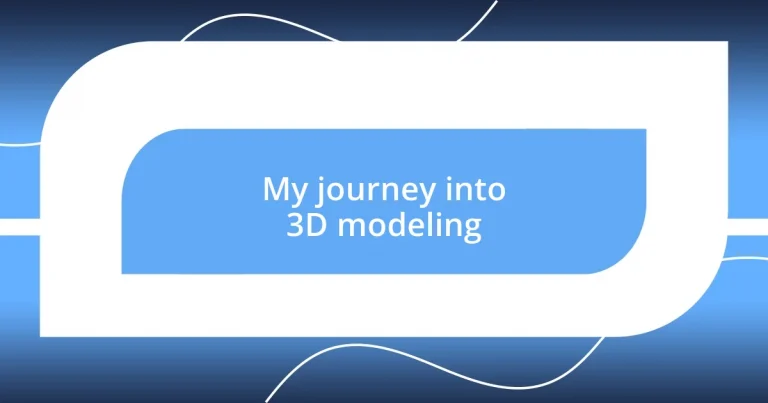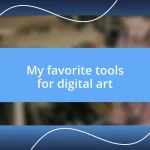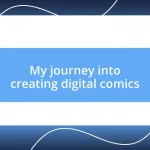Key takeaways:
- The journey of 3D modeling begins with exploration and experimentation, turning frustration into creativity through continuous practice and learning.
- Essential tools like Blender and Tinkercad are crucial for beginners, while mastering techniques such as polygon modeling, texturing, and lighting enhances the quality of projects.
- Collaboration and feedback from other artists significantly enrich the learning experience, pushing creative boundaries and leading to personal growth in modeling skills.
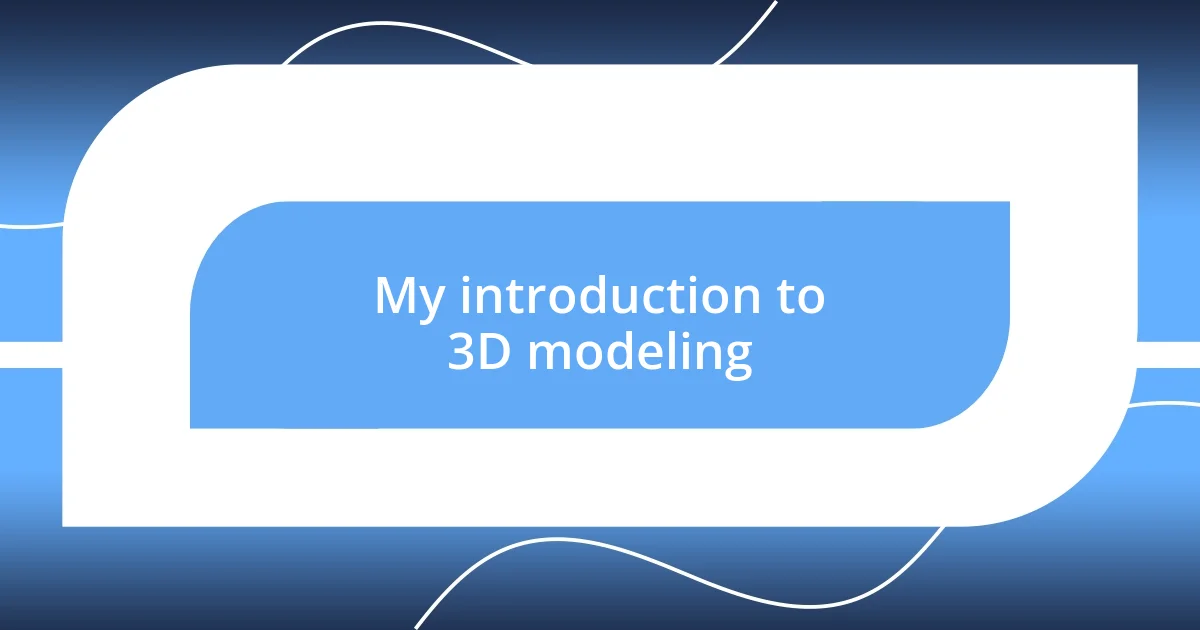
My introduction to 3D modeling
I still remember the first time I stumbled upon a 3D modeling tutorial online. It felt like opening a door to a new world, where creativity and technology intertwined seamlessly. The software seemed daunting at first, but I felt an itch to dive deeper—was I ready to create something from scratch?
As I tinkered with basic shapes, I experienced an exhilarating mix of frustration and excitement. Each failed attempt taught me something new about perspective and dimensions, refining my eye for detail. I vividly recall the moment I managed to mold my first model—a simple cup. It was a small victory, but I felt a surge of pride, realizing that this was just the beginning of my journey.
The beauty of 3D modeling lies in its potential for limitless expression. I often found myself lost in the process, wondering, “What else can I create?” This question fueled countless late nights, sculpting not just objects, but my understanding of digital art and design. With each project, I discovered more about myself and found joy in turning ideas into tangible forms.
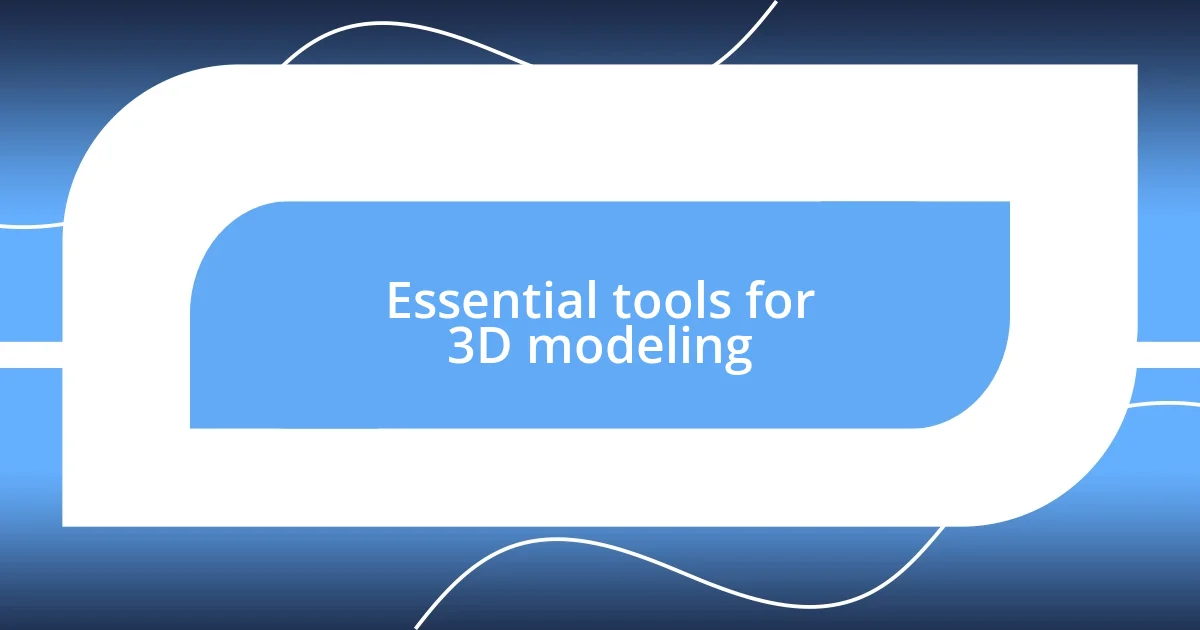
Essential tools for 3D modeling
When I think about the essential tools for 3D modeling, the first ones that come to mind are the software platforms that serve as our digital canvases. I’ve tried a variety, but some consistently stand out. Blender is a powerful and free tool that I’ve grown particularly fond of; its robust capabilities can make even the most intricate designs possible. For my earlier projects, I relied heavily on Tinkercad. It’s incredibly user-friendly, allowing beginners to grasp the basic concepts without feeling overwhelmed.
Here’s a quick list of essential tools that I believe every aspiring 3D modeler should consider:
- Blender: Free and open-source software, perfect for complex projects.
- Autodesk Maya: A professional-grade software loved for its advanced features, though it comes at a cost.
- Tinkercad: Ideal for beginners, it’s web-based and easy to use for simple designs.
- ZBrush: A go-to for sculpting and adding intricate details to models.
- SketchUp: Excellent for architectural designs and straightforward to navigate.
Exploring and choosing the right tool was an adventure in itself. I remember being overwhelmed by the vast options available, but experimenting with different platforms made all the difference in finding my style. Each software has unique advantages that cater to specific modeling needs, allowing you to express your creativity in various ways. Admittedly, I’ve spent countless hours sifting through tutorials and community forums, passionately searching for tips and tricks to enhance my skills.
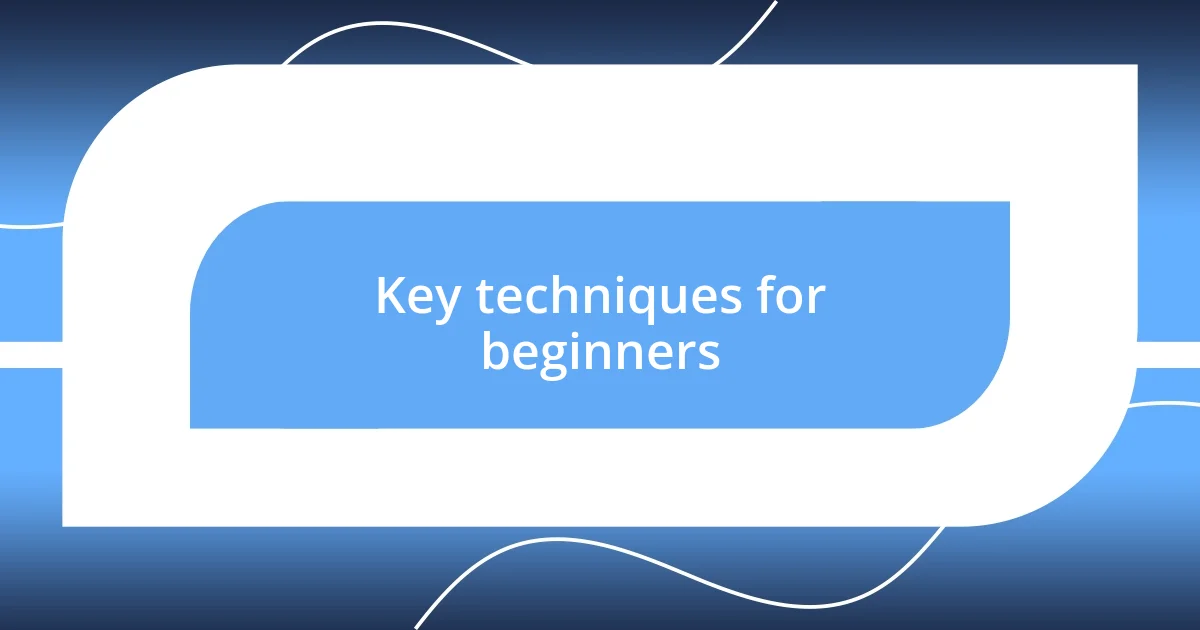
Key techniques for beginners
Mastering the key techniques in 3D modeling can feel overwhelming at first, but breaking it down helps. I can clearly remember dedicating hours to learning about polygon modeling, which became a cornerstone of my skill set. It was fascinating to see how simple shapes create complex structures, and my early models were a testament to that—haphazard yet full of potential.
Another important technique is texturing, which adds life and realism to your creations. I recall the first time I successfully applied a texture to a model; the satisfaction was profound. Suddenly, that plain coffee cup transformed into something that made my heart race. Understanding how to unwrap UVs and apply textures profoundly changed my perception of 3D art.
Lastly, lighting and rendering are crucial for bringing your models to life. I’ll never forget stumbling through the rendering settings and finally achieving an image that looked almost photo-realistic. It was a pivotal moment that deepened my appreciation for the art of presentation. Seeing my work in a beautiful light added a layer of pride I hadn’t expected.
| Technique | Description |
|---|---|
| Polygon Modeling | Creating complex shapes from basic geometric forms; foundation of most 3D designs. |
| Texturing | Applying images and patterns to models, enhancing realism and detail. |
| Lighting and Rendering | Setting up lights for realistic effects and converting models into images or animations. |
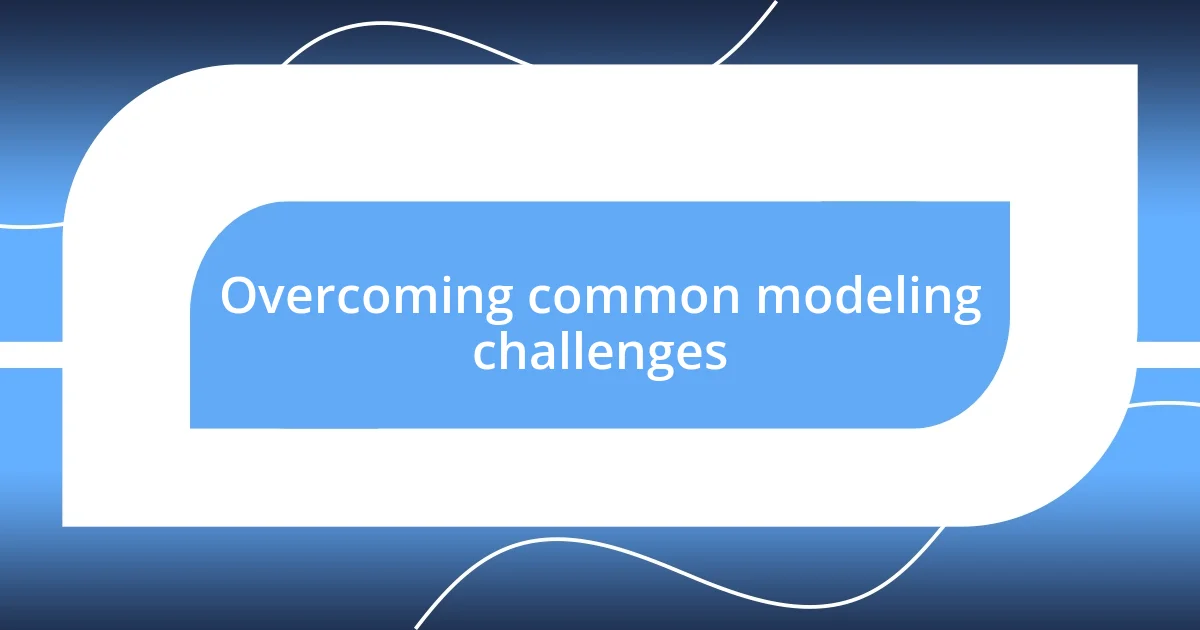
Overcoming common modeling challenges
Over the years, I’ve encountered numerous challenges while modeling in 3D, but learning to tackle them became part of my journey. For instance, I vividly remember struggling with the scale of my objects. At first, everything seemed too big or too small, which made my models feel disconnected. I quickly realized that creating a simple reference object—a realistic human figure or a standard cube—let me maintain proper proportions throughout my projects. Isn’t it incredible how a small adjustment can make such a significant difference?
Another common hurdle is maintaining mesh integrity; I can recall numerous times when I ended up with weird artifacts that stubbornly clung to my models. During one particularly confusing session, I learned the importance of edge flow and how it impacts animation. By consciously focusing on proper edge loops and ensuring my polygons were clean, I not only improved my modeling precision but also added years to the life of my projects. Have you ever found those pesky little issues ruining your hard work?
Finally, dealing with rendering frustrations can test anyone’s patience. I’ll never forget the moment I left my computer rendering overnight, only to wake up to a blurry mishmash instead of the masterpiece I was expecting. This experience taught me the value of understanding the rendering settings in depth. Now, I’m meticulous about checking resolution and sampling rates before hitting that render button—because, let’s face it, nothing feels more defeating than lost time on something that could have easily been prevented. How have your rendering experiences influenced your work?
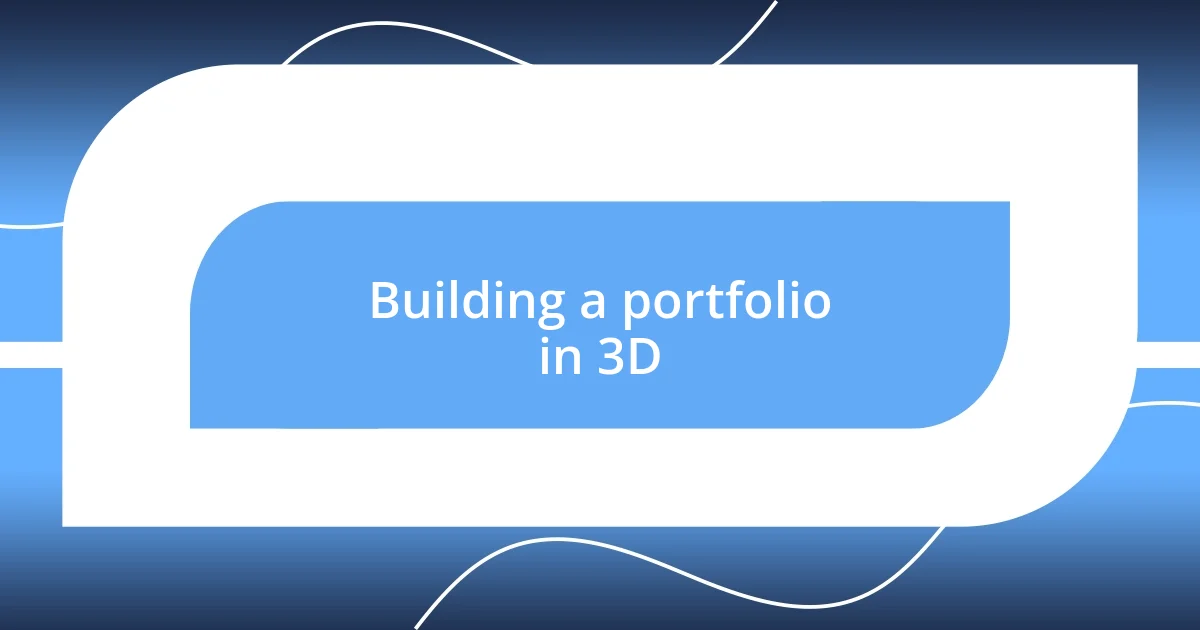
Building a portfolio in 3D
Building a portfolio in 3D is essential for showcasing your skills and attracting potential clients or employers. I remember the thrill of curating my portfolio; each model felt like a reflection of my growth. It’s important to select pieces that not only demonstrate your technical abilities but also tell a story about your artistic journey.
When I first started, my portfolio was a jumble of different styles, which lacked cohesion. It wasn’t until I focused on a specific niche—like character modeling—that my work began to resonate more with viewers. Have you ever found that narrowing your focus can amplify the impact of your creations? This strategic selection not only clarified my personal style but also helped me connect with the types of projects I genuinely wanted to pursue.
I also discovered the power of presentation. I vividly remember re-shooting the renders of my models against clean backgrounds and consistent lighting. This change not only elevated the quality of my portfolio but infused it with a professional touch that attracted more attention. It’s amazing how the right presentation can transform your work. Are you giving your models the backdrop they deserve?
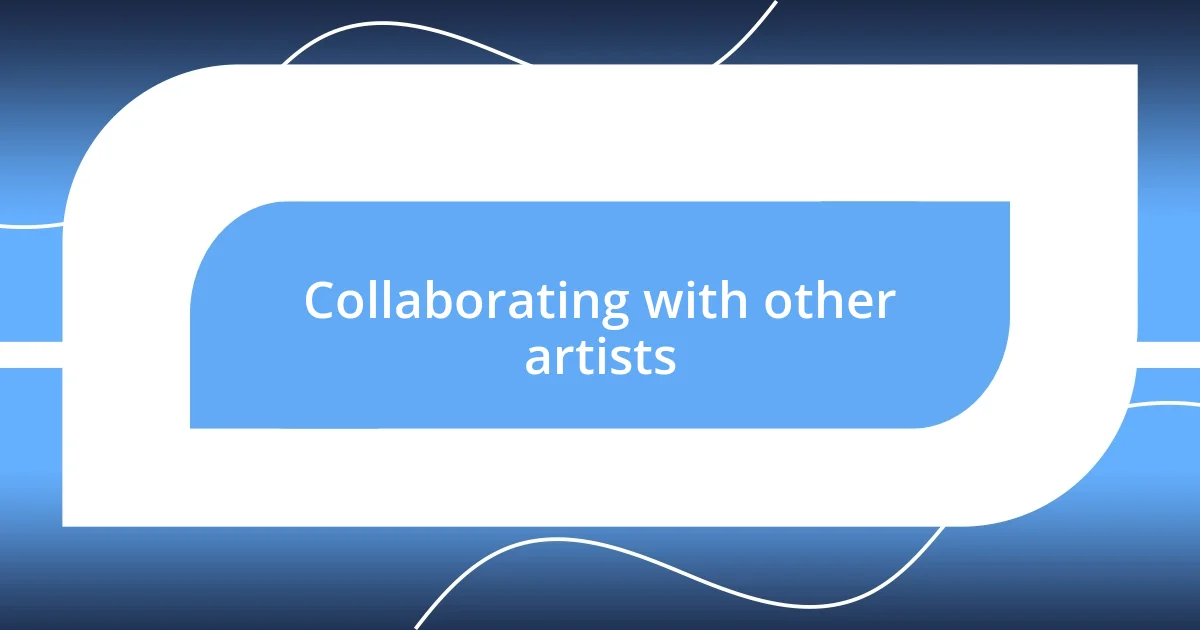
Collaborating with other artists
Collaborating with other artists has been one of the most rewarding aspects of my 3D modeling journey. I remember one particular project where I teamed up with a talented texture artist. As we shared our visions, it felt like a light bulb moment when she asked for my input while creating textures. Her willingness to incorporate my feedback not only improved the final product but also strengthened our working relationship. Have you ever had a collaboration that brought out the best in your work?
In another instance, I joined a group of fellow 3D artists for a joint exhibition. The experience taught me how invaluable diverse perspectives can be. Each artist brought their unique flair, complementing my style in unexpected ways. It was a fascinating process, watching how our collective ideas meshed to create something that none of us could have achieved alone. Does collaborating inspire you to push your creative boundaries?
I found that open communication is the key to successful collaboration. Early on, I struggled to voice my thoughts during group sessions, but I quickly learned that sharing my ideas led to richer discussions and better outcomes. Now, I actively engage with my collaborators, brainstorming and troubleshooting together, which often sparks new inspirations. How do you ensure everyone’s voice is heard in a team setting?
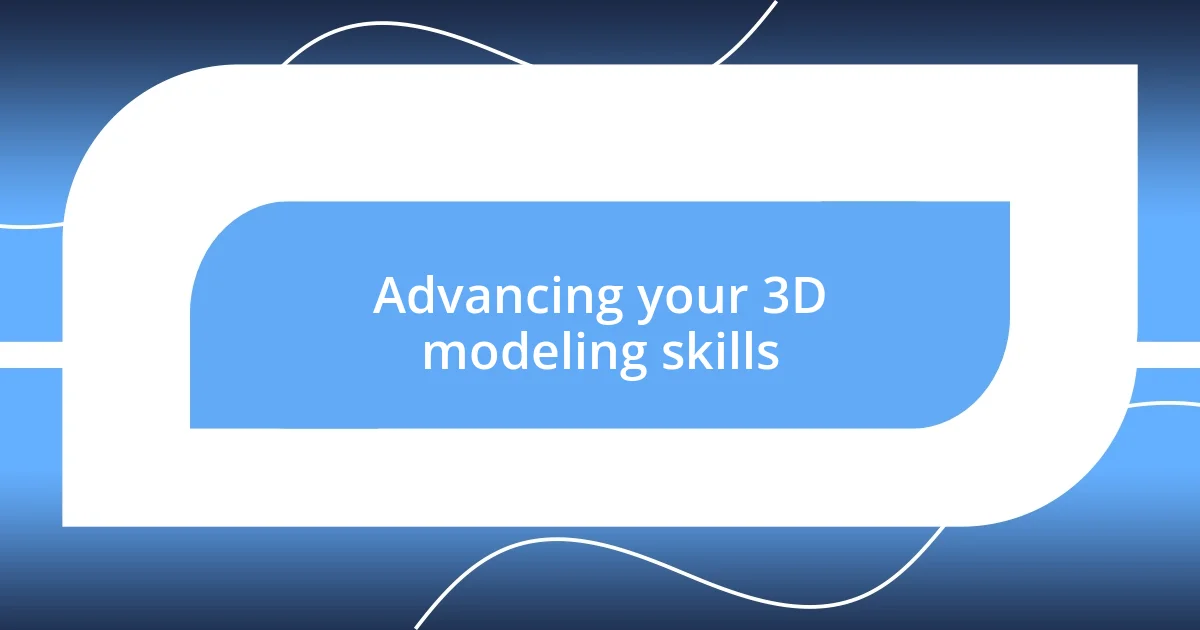
Advancing your 3D modeling skills
Advancing your 3D modeling skills often requires venturing out of your comfort zone. I vividly recall the first time I attempted to learn ZBrush. The initial struggle with its interface left me feeling frustrated, yet pushing through those challenges proved immensely rewarding. Have you ever faced a steep learning curve that ultimately paid off? Each time I successfully completed a complex sculpt, I felt my confidence grow, reflecting how perseverance can lead to mastery.
Practice, coupled with constructive feedback, plays a vital role in skill advancement. I remember sharing my work online and receiving critiques that felt daunting at first. However, I soon realized that these insights, though sometimes hard to hear, were invaluable for my growth. Engaging with a supportive community can be a game-changer. What’s your experience with feedback? Embracing it, rather than fearing it, has allowed me to refine my techniques and approach each new project with a fresh perspective.
Additionally, setting personal challenges can ignite your creativity. One year, I decided to create a different 3D model every week, each one focusing on a new technique or style. This project not only expanded my portfolio but also celebrated the diversity of my growing skill set. It was both exhilarating and eye-opening. Have you tried challenging yourself in a structured way? I found that such goals made the learning process feel like an adventure rather than a chore.












